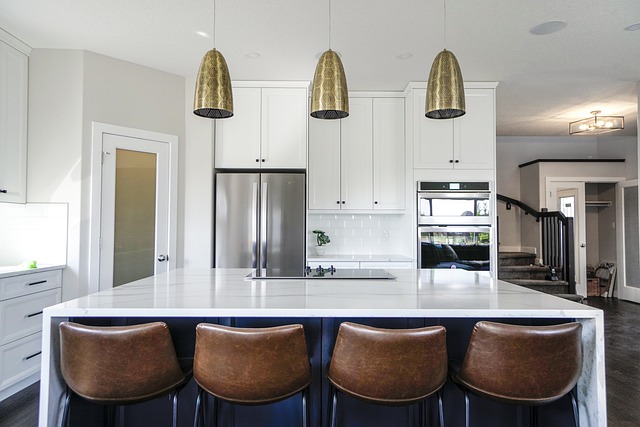Old kitchen appliances can drive up energy bills and harm the environment due to inefficient technology. Upgrading to modern LED lights significantly reduces energy usage, carbon footprint, and utility expenses in the long run. Low-energy lighting offers improved brightness, less heat, longer lifespans, smart features, and design flexibility. A practical guide suggests assessing current appliances, creating a budget, and replacing lighting fixtures sequentially while monitoring energy bills to track savings. Despite higher upfront costs, modern appliances lead to substantial financial and environmental benefits over time, making the switch to low-energy lighting for kitchens a wise choice.
Looking to slash your energy bills and reduce your environmental impact? It’s time to say goodbye to outdated, energy-draining appliances. This guide explores the significant role old kitchen fixtures play in sky-rocketing utility costs and delves into the benefits of upgrading to modern, low-energy lighting alternatives. Discover efficient solutions tailored for kitchens, from LED bulbs to smart controls, offering both long-term savings and a greener future.
Understanding the Impact of Old Appliances on Energy Consumption
Old appliances, often found in homes and businesses, can be significant contributors to high energy consumption. These outdated devices are designed with less efficient technologies, leading to excessive power usage and subsequent higher electricity bills. In today’s eco-conscious world, it’s essential to recognize the impact of such appliances on both your wallet and the environment.
When it comes to kitchens, low-energy lighting for kitchens is a prime example of an upgrade that can make a substantial difference. Modern LED lights, for instance, consume far less energy than traditional incandescent bulbs while offering improved brightness and longevity. By replacing old appliances with energy-efficient models and incorporating innovative solutions like smart lighting systems, you can significantly reduce your carbon footprint and enjoy long-term savings on utility expenses.
Benefits of Upgrading to Low-Energy Lighting in Kitchens
Upgrading to low-energy lighting in kitchens offers a plethora of benefits that go beyond simply reducing electricity bills. Modern LED lights, for instance, consume significantly less energy than traditional incandescent bulbs, cutting down on power usage and environmental impact. This switch not only leads to long-term cost savings but also contributes to sustainable living by decreasing carbon footprints.
Moreover, low-energy lighting systems often provide better light quality and longer lifespans. They emit less heat, making kitchens cooler and more comfortable, while their durability means fewer replacements over time. This results in reduced waste and further saves on disposal costs. In addition, many energy-efficient lights come with smart features, allowing for easy control and programming to suit various kitchen activities, enhancing both functionality and efficiency.
Exploring Modern Alternatives: Efficient Kitchen Lightings
When it comes to modernizing your kitchen, exploring efficient lighting options is a great place to start. Low-energy lighting for kitchens is no longer just an eco-friendly choice but a practical and cost-effective one too. LED lights have revolutionized kitchen lighting with their energy efficiency and longevity. These bulbs use significantly less electricity than traditional incandescent or fluorescent lights, reducing your utility bills and carbon footprint.
Not only are low-energy lightings for kitchens more environmentally friendly, but they also offer a range of design options to suit any aesthetic. From sleek, minimalist fixtures to rustic, industrial styles, LED lighting can enhance the overall ambiance while ensuring optimal visibility during meal preparation and eating.
Step-by-Step Guide to Replacing Old Appliances
Step-by-Step Guide to Replacing Old Appliances
Start by assessing your current kitchen appliances and identifying those that consume the most energy. Look for old models, especially ones with incandescent bulbs instead of low-energy lighting like LED lights. Research and select modern alternatives known for their energy efficiency—LED lights in the kitchen are a great place to begin, offering significant power savings over traditional options.
Next, create a budget and timeline. Compare prices online and consider sales or promotions. Once you’ve decided on replacements, start replacing old appliances one by one. Install low-energy lighting fixtures like LED bulbs in places like overhead lights or under-cabinet lighting. Ensure proper installation for safety and optimal performance. Regularly check energy bills to track the savings from your new, energy-efficient appliances.
Long-Term Savings and Environmental Considerations
Upgrading to modern, energy-efficient appliances can bring significant long-term savings for homeowners. While initial investment costs may be higher than traditional models, low-energy lighting for kitchens and other areas in your home can drastically reduce utility bills over time. These new appliances are designed to consume less power, which means lower electricity or gas expenses for years to come.
Moreover, environmental considerations make this transition even more compelling. By choosing energy-saving alternatives, you’re contributing to a reduction in carbon footprint and conserving natural resources. Modern appliances often incorporate eco-friendly features, such as LED technology in low-energy lighting, which uses less electricity than traditional incandescent bulbs. This shift not only benefits your wallet but also supports global efforts to create a more sustainable future.
By replacing old appliances, especially in kitchens, with modern, energy-efficient alternatives like low-energy lighting, we can significantly reduce our carbon footprint. This simple step not only results in long-term savings on energy bills but also contributes to a greener planet. Embracing these advancements is key to a more sustainable future, where efficient kitchen lightings play a vital role in minimizing energy consumption and environmental impact.
